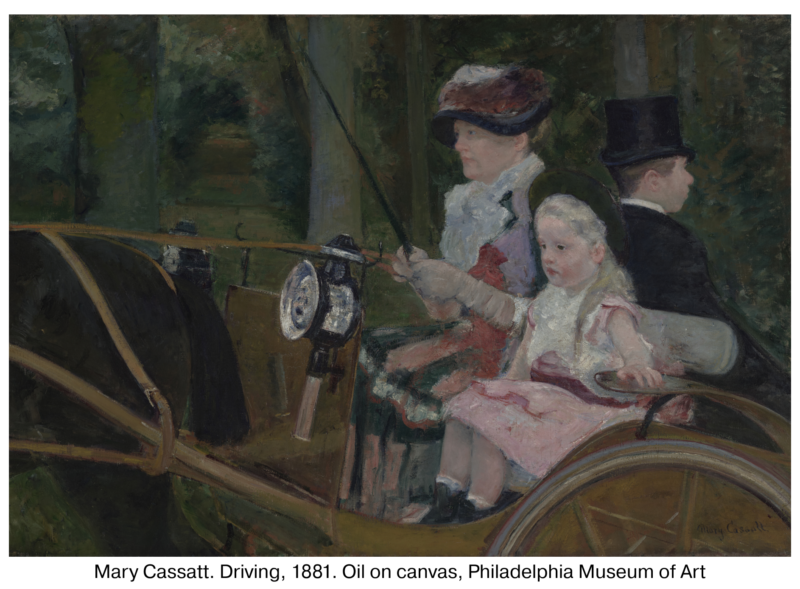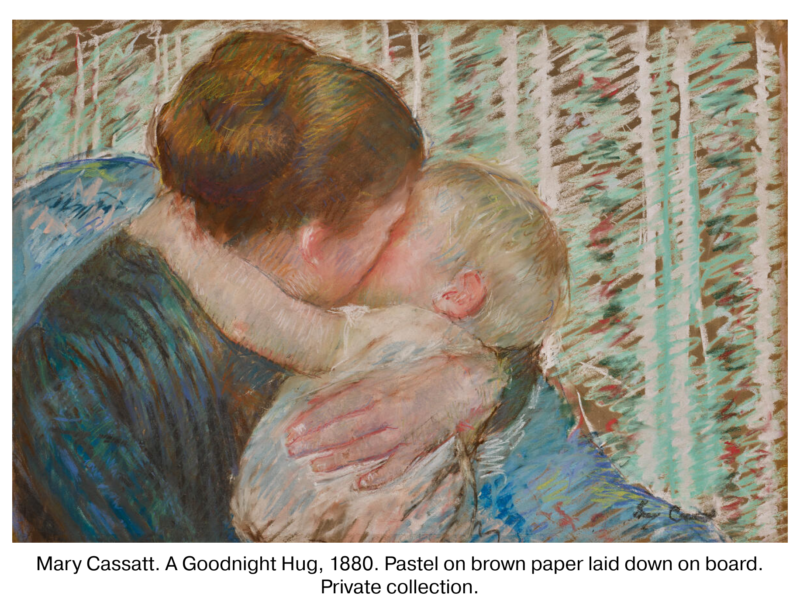
On May 18, the Philadelphia Museum of Art will open a large-scale exhibition titled “Mary Cassatt at Work,” featuring 130 works by the celebrated French Impressionist painter. The show is the result of a two-year research project on the museum’s holdings and will shed new light on Cassatt’s art and creative process.
Ahead of the exhibition, Fine Art Shippers, a corporate partner of the Philadelphia Museum of Art, had the opportunity to interview Jennifer Thompson, Head of the European Art Department at PMA, to discuss Cassatt and the new findings about her work.
Mary Cassatt at Work: Interview with a PMA Curator
“Mary Cassatt at Work” is the first major showing of the artist’s oeuvre in the US since 1998–99. Why have there been no exhibitions for such a long time?
Jennifer Thompson: Despite the lack of major US exhibitions over the past decade, Mary Cassatt remains a significant figure in the art world; she has not been forgotten in any way. Her work has been displayed in major exhibitions in Paris and Japan. In the US, she was featured in thematic exhibitions, for example, in a 2015 show dedicated to Paul Durand-Ruel, an art dealer associated with the Impressionists. The Philadelphia Museum of Art has eighty-four of Mary Cassatt’s works, so it felt timely to revisit her legacy. Our upcoming exhibition offers new insights, featuring both well-known pieces and lesser-seen works that have not been on public display for decades.
Why did you choose to focus on her work process as a theme?
Mary Cassatt’s paintings can often be seen in books and media. However, we know little about her artistic process and daily life. Unfortunately, she hasn’t left us much information in that regard. There are no photographs of her studio, and she allowed very few people to see her at work. So, there are a lot of questions: How did she work? What did her studio look like? How did she structure her days?
This led the curatorial and conservation staff of the Philadelphia Museum of Art to undertake a two-year study of the Cassatts in our collection. During this research project, we examined them in our conservation studios using X-radiography and infrared reflectogram imaging to better understand her technique and process.
Could you elaborate on what you discovered through your research?
I need to preface this by saying that although we’ve been intently studying Cassatt’s works for two years, I believe that exploring her oeuvre will occupy the rest of my career. There is still so much to learn. In terms of her paintings, we are just beginning to grasp their depth.
Speaking about her technique, it’s important to note that she was exceptionally well-trained. Cassatt first attended the Pennsylvania Academy of the Fine Arts in Philadelphia, then spent around twelve years in Europe, where she intermittently studied under seven different artists. During this time, she immersed herself in the study of Renaissance, Dutch, and Spanish paintings.
Cassatt’s deep engagement with the Old Masters and historical art resulted in extraordinarily well-crafted pictures. This high level of craftsmanship might explain why her paintings have required minimal intervention from modern conservators—her works have endured remarkably well.
With her exceptional training, she had the ability and know-how to experiment. In several of her paintings, she employed extensive scraping techniques, using them not only to modify but also to highlight different elements of the surface, creating a textured effect. She also manipulated paint with the end of her brush to add detail to her paintings.
A distinctive feature in her work is a sharp, incised line around the edges of faces, reminiscent of drypoint prints. This confident use of the line indicates that she adapted printmaking techniques into her painting.
Cassatt also worked extensively with pastels. Although she is often recognized primarily as a painter, her known oeuvre includes 380 pastels, 320 paintings, and about 250 prints. This variety in her work stands out compared to her Impressionist peers, who usually focused on just one medium. Although Degas and Pissarro experimented with prints, they didn’t explore as many different types of printmaking as Cassatt did.
Speaking of Degas, Mary Cassatt and Edgar Degas maintained an artistic friendship for many years. How did this relationship influence her art?
Degas and Cassatt first met around 1877, three years after Cassatt had moved to Paris. By then, she was an accomplished and well-established artist, having exhibited at the Salon and sold numerous works. Their encounter became more of a connection between two like-minded artists than a mentorship. They supported and inspired each other in their work.
A 2014 exhibition at the National Gallery of Art in Washington, D.C., showcased the mutual influence between Degas and Cassatt, challenging the traditional view of Cassatt as Degas’s student. It highlighted instances of artistic borrowing between the two, illustrating their relationship as one of equals.
Degas and Cassatt’s artistic collaboration was most active in the late 1870s and early 1880s, around the time Cassatt joined the Impressionists. During this period, she explored new pastel techniques. For instance, in one pastel shown in the 1879 exhibition, she first sketched a fan in distemper on canvas, then layered it with pastel and metallic paint. While it’s often assumed Degas first used metallics, it’s not certain who actually started this technique.
Now, I would like to discuss the feminist themes, specifically the depiction of women and children, in Cassatt’s works. How were these perceived during her lifetime?
When Mary Cassatt first joined the Impressionists in 1879, she was very well received. For example, her painting “Woman in the Loge” was particularly noted for its compositional complexity. It shows a woman seated in front of a mirror, with a reflection of the theater behind her—an intricate visual that art critics saw as a display of her skill. Unlike many male artists of her time who portrayed women in passive roles, Cassatt depicted their activity in scenes of bathing a child or driving a carriage, challenging traditional representations. However, her contemporaries often missed feminist aspects of her work, such as in “Woman with a Sunflower,” which featured a symbol of the US Suffrage Movement—a detail not picked up by newspaper criticism at the time but recognized in recent years.
How did Mary Cassatt’s work develop over time?
Our museum is fortunate to have a collection that spans the entire career of this artist, with the earliest piece dating to 1873-74 and the latest to 1908. Initially, her work shows influences from Murillo, Manet, and Velasquez through her use of glazes and composition techniques.
Over time, her style evolves noticeably. In the 1890s, she began leaving parts of the canvas intentionally blank, suggesting a sense of incompleteness. However, these artworks are signed, indicating that she considered them finished. This period reveals more about her artistic process, often showing her sketching directly on the canvas with oil paint.
In her later years, her approach to painting becomes more about displaying her technique with bold, impressionistic strokes. Her color choices also become brighter, with a preference for vivid oranges and pinks, and a focus on layering colors.
The themes of her art change too. Initially depicting theater scenes and women in public settings, after 1880, she shifts her focus towards domestic scenes, especially women and children.
Do we know anything about her relationships with the models in her works?
She often painted her family, especially her sister Lydia, in the 1870s and early 1880s. Beyond her family, she worked with a range of other models. The mothers and children in her paintings weren’t always related. She found sitters in her everyday surroundings: maids, neighborhood children, and even a Swedish seamstress from the Worth Fashion House. It appears she also shared models with Berthe Morisot and Degas.
Could you tell us a little about the architecture of “Mary Cassatt at Work”?
The exhibition features a variety of Mary Cassatt’s works, including paintings, pastels, and prints. We have chosen to mix these media together because Cassatt worked with them interchangeably throughout her career. Instead of arranging the artwork by date, we are organizing it by theme. There will be sections dedicated to depictions of women in public spaces, women in private settings, and women engaging in handwork, such as sewing and crocheting, or playing music. Childcare is another key theme. This thematic layout allows us to show how Cassatt’s interests in these subjects evolved over her 50-year career.
Lastly, what public program events are in store for the visitors?
As part of the exhibition, we are organizing a panel featuring contemporary female artists to discuss their experiences and the challenges they face today. In addition, a session with museum curators and conservators will look into the technical aspects of Cassatt’s artistry, especially her portrayals of hands. Our summer program for families will include storybook hours featuring books with Cassatt’s images.
We are also preparing a Smartify audio tour, which is included in the admission price. This tour features recordings of Cassatt’s own words, allowing visitors to engage directly with her thoughts on her work.
Interview by Inna Logunova
Photo courtesy of the Philadelphia Museum of Art
Featured image:
In the Loge, 1879. Pastel with gold metallic paint on canvas
Philadelphia Museum of Art, Gift of Mrs Sargent McKean




